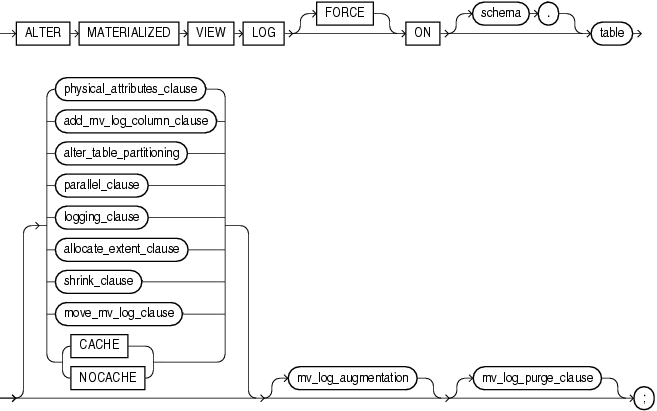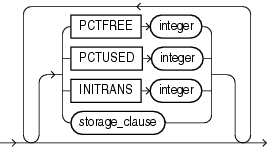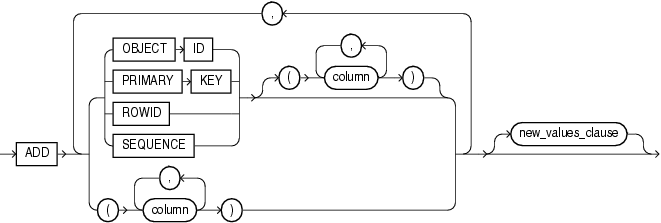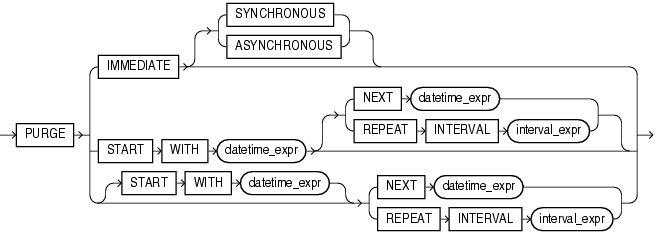| Oracle® Database SQL Language Reference 11g Release 2 (11.2) E41084-02 |
|
|
PDF · Mobi · ePub |
| Oracle® Database SQL Language Reference 11g Release 2 (11.2) E41084-02 |
|
|
PDF · Mobi · ePub |
A materialized view log is a table associated with the master table of a materialized view. Use the ALTER MATERIALIZED VIEW LOG statement to alter the storage characteristics or type of an existing materialized view log.
Note:
The keywordSNAPSHOT is supported in place of MATERIALIZED VIEW for backward compatibility.See Also:
CREATE MATERIALIZED VIEW LOG for information on creating a materialized view log
ALTER MATERIALIZED VIEW for more information on materialized views, including refreshing them
CREATE MATERIALIZED VIEW for a description of the various types of materialized views
You must be the owner of the master table or you must have the SELECT privilege on the master table and the ALTER privilege on the materialized view log.
See Also:
Oracle Database Advanced Replication for detailed information about the prerequisites forALTER MATERIALIZED VIEW LOGalter_materialized_view_log::=

(physical_attributes_clause::=, add_mv_log_column_clause::=, alter_table_partitioning ::= (in ALTER TABLE), parallel_clause::=, logging_clause::=, allocate_extent_clause::=, shrink_clause::=, move_mv_log_clause::=, mv_log_augmentation::=,mv_log_purge_clause::=.)


![]()
Description of the illustration move_mv_log_clause.gif




If you specify FORCE and any items specified with the ADD clause have already been specified for the materialized view log, then Oracle Database does not return an error, but silently ignores the existing elements and adds to the materialized view log any items that do not already exist in the log. Likewise, if you specify INCLUDING NEW VALUES and that attribute has already been specified for the materialized view log, Oracle Database ignores the redundancy and does not return an error.
Specify the schema containing the master table. If you omit schema, then Oracle Database assumes the materialized view log is in your own schema.
Specify the name of the master table associated with the materialized view log to be altered.
The physical_attributes_clause lets you change the value of the PCTFREE, PCTUSED, and INITRANS parameters and the storage characteristics for the materialized view log, the partition, the overflow data segment, or the default characteristics of a partitioned materialized view log.
Restriction on Materialized View Log Physical Attributes You cannot use the storage_clause to modify extent parameters if the materialized view log resides in a locally managed tablespace. Refer to CREATE TABLE for a description of these parameters.
When you add a column to the master table of the materialized view log, the database does not automatically add a column to the materialized view log. Therefore, use this clause to add a column to the materialized view log. Oracle Database will encrypt the newly added column if the corresponding column of the master table is encrypted.
The syntax and general functioning of the partitioning clauses is the same as described for the ALTER TABLE statement. Refer to alter_table_partitioning in the documentation for ALTER TABLE.
Restrictions on Altering Materialized View Log Partitions Altering materialized view log partitions is subject to the following restrictions:
You cannot use the LOB_storage_clause or modify_LOB_storage_clause when modifying partitions of a materialized view log.
If you attempt to drop, truncate, or exchange a materialized view log partition, then Oracle Database raises an error.
The parallel_clause lets you specify whether parallel operations will be supported for the materialized view log.
For complete information on this clause, refer to parallel_clause in the documentation on CREATE TABLE.
Specify the logging attribute of the materialized view log. Refer to the logging_clause for a full description of this clause.
Use the allocate_extent_clause to explicitly allocate a new extent for the materialized view log. Refer to allocate_extent_clause for a full description of this clause.
Use this clause to compact the materialized view log segments. For complete information on this clause, refer to shrink_clause in the documentation on CREATE TABLE.
Use the MOVE clause to move the materialized view log table to a different tablespace, to change other segment or storage attributes of the materialized view log, or to change the parallelism of the materialized view log.
Restriction on Moving Materialized View Logs The ENCRYPT clause of the storage_clause of segment_attributes is not valid for materialized view logs.
For data that will be accessed frequently, CACHE specifies that the blocks retrieved for this log are placed at the most recently used end of the LRU list in the buffer cache when a full table scan is performed. This attribute is useful for small lookup tables. NOCACHE specifies that the blocks are placed at the least recently used end of the LRU list. Refer to "CACHE | NOCACHE | CACHE READS" in the documentation on CREATE TABLE for more information about this clause.
Use the ADD clause to augment the materialized view log so that it records the primary key values, rowid values, object ID values, or a sequence when rows in the materialized view master table are changed. This clause can also be used to record additional columns.
To stop recording any of this information, you must first drop the materialized view log and then re-create it. Dropping the materialized view log and then re-creating it forces a complete refresh for each of the existing materialized views that depend on the master table on its next refresh.
Restriction on Augmenting Materialized View Logs You can specify only one PRIMARY KEY, one ROWID, one OBJECT ID, one SEQUENCE, and each column in the column list once for each materialized view log. You can specify only a single occurrence of PRIMARY KEY, ROWID, OBJECT ID, SEQUENCE, and column list within this ALTER statement. Also, if any of these values was specified at create time (either implicitly or explicitly), you cannot specify that value in this ALTER statement unless you use the FORCE option.
OBJECT ID Specify OBJECT ID if you want the appropriate object identifier of all rows that are changed to be recorded in the materialized view log.
Restriction on the OBJECT ID clause You can specify OBJECT ID only for logs on object tables, and you cannot specify it for storage tables.
PRIMARY KEY Specify PRIMARY KEY if you want the primary key values of all rows that are changed to be recorded in the materialized view log.
ROWID Specify ROWID if you want the rowid values of all rows that are changed to be recorded in the materialized view log.
SEQUENCE Specify SEQUENCE to indicate that a sequence value providing additional ordering information should be recorded in the materialized view log.
column Specify the additional columns whose values you want to be recorded in the materialized view log for all rows that are changed. Typically these columns are filter columns (non-primary-key columns referenced by subquery materialized views) and join columns (non-primary-key columns that define a join in the WHERE clause of the subquery).
See Also:
CREATE MATERIALIZED VIEW for details on explicit and implicit inclusion of materialized view log values
Oracle Database Advanced Replication for more information about filter columns and join columns
The NEW VALUES clause lets you specify whether Oracle Database saves both old and new values for update DML operations in the materialized view log. The value you set in this clause applies to all columns in the log, not only to columns you may have added in this ALTER MATERIALIZED VIEW LOG statement.
INCLUDING Specify INCLUDING to save both new and old values in the log. If this log is for a table on which you have a single-table materialized aggregate view, and if you want the materialized view to be eligible for fast refresh, then you must specify INCLUDING.
EXCLUDING Specify EXCLUDING to disable the recording of new values in the log. You can use this clause to avoid the overhead of recording new values.
If you have a fast-refreshable single-table materialized aggregate view defined on this table, then do not specify EXCLUDING NEW VALUES unless you first change the refresh mode of the materialized view to something other than FAST.
Use this clause alter the purge attributes of the materialized view log in the following ways:
Change the purge from IMMEDIATE SYNCHRONOUS to IMMEDIATE ASYNCHRONOUS or from IMMEDIATE ASYNCHRONOUS to IMMEDIATE SYNCHRONOUS
Change the purge from IMMEDIATE to scheduled or from scheduled to IMMEDIATE
Specify a new start time and a new next time and interval
If you are altering purge from scheduled to IMMEDIATE, then the scheduled purged job associated with that materialized view log is dropped. If you are altering purge from IMMEDIATE to scheduled, then a purge job is created with the attributes provided. If you are altering scheduled purge attributes, then only those attributes specified will be changed in the scheduler purge job.
You must specify FORCE if you are altering log purge to its current state (that is, you are not making any change), unless you are changing scheduled purge attributes.
To learn whether the purge time or interval has already been set for this materialized view log, query the *_MVIEW_LOGS data dictionary views. See the CREATE MATERIALIZED VIEW LOG clause mv_log_purge_clause for the full semantics of this clause.
Rowid Materialized View Log: Example The following statement alters an existing primary key materialized view log to also record rowid information:
ALTER MATERIALIZED VIEW LOG ON order_items ADD ROWID;
Materialized View Log EXCLUDING NEW VALUES: Example The following statement alters the materialized view log on hr.employees by adding a filter column and excluding new values. Any materialized aggregate views that use this log will no longer be fast refreshable. However, if fast refresh is no longer needed, this action avoids the overhead of recording new values:
ALTER MATERIALIZED VIEW LOG ON employees ADD (commission_pct) EXCLUDING NEW VALUES;